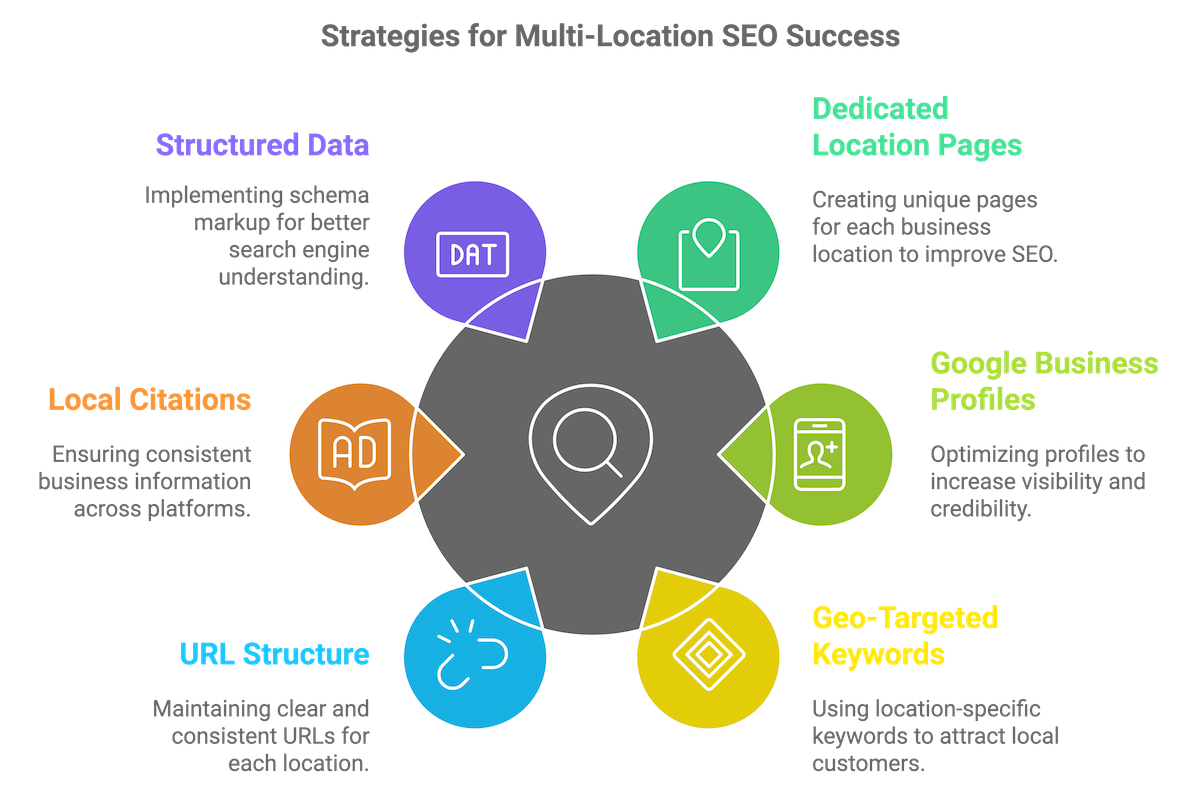SEO for Multiple Locations: A 2024 Strategy to Boost Your Business
By: Hayden Jarman

If your business operates across multiple locations, you’ve probably noticed that optimizing your online presence is a constant challenge.
Here’s the good news: you’re not alone. Nearly 46% of all Google searches have local intent, and over 76% of those local searches lead to an in-store visit within 24 hours [1]. That’s a massive opportunity for businesses that nail their local SEO strategy.
Today you’ll learn how to optimize for multi-location SEO, backed by data and actionable steps.
Table of Contents:
- The Rising Importance of Multi-Location SEO
- Creating Dedicated Location Pages
- Optimizing Google Business Profiles
- Local Keyword Research: Go Hyperlocal
- URL Structure and Local Citations
- Boosting Local Rankings with Structured Data
- Local Backlink Building
- Common Pitfalls to Avoid
- Hyperlocal Content: How It’s Driving SEO Success
- The Final Word on Multi-Location SEO
📊 How Optimized is Your Business for Multi-Location SEO? 🔍
The Rising Importance of Multi-Location SEO
Let’s start with the facts:
- Nearly 75% of consumers conduct local searches weekly [2].
- Over 800 million monthly searches in the U.S. contain some variation of “near me” [2].
- Google reports that 76% of all local smartphone searches lead to an in-store visit within 24 hours [2].
That’s a huge volume of potential customers searching for local businesses like yours.
| Metric | Statistic |
|---|---|
| Weekly local searches | 75% of consumers search locally weekly |
| “Near me” searches | 800 million searches monthly in the U.S. |
| Local search conversion | 76% result in in-store visits within 24 hours |

Creating Dedicated Location Pages
One of the most critical components of multi-location SEO is having separate pages for each of your business locations.
You don’t want to lump all your branches onto a single page. Doing so makes it harder for Google to rank you well for local searches.
Best Practices for Location Pages:
- Unique content for each location (avoid duplicate content issues).
- Include NAP (Name, Address, Phone) in a prominent position.
- Embed Google Maps on each location page.
- Use location schema markup for better search engine understanding.
Example: Starbucks has location-specific pages that offer details like store hours, address, and local promotions. You should aim for a similar model.
Learn more about Local SEO strategies for small businesses.
Optimizing Google Business Profiles
Your Google Business Profile (formerly Google My Business) is one of the most powerful tools for local SEO.
According to Google, businesses with complete and updated profiles are 2.7 times more likely to be considered reputable.
Actionable Steps for Google Business Profiles:
- Create and manage a separate Google Business Profile for every location.
- Ensure the NAP is consistent across profiles.
- Regularly update photos, operating hours, and service offerings.
- Encourage local reviews, and respond to each one—positive or negative.
How to optimize your Google Business Profile.
Local Keyword Research: Go Hyperlocal
When it comes to local SEO, one size doesn’t fit all. Each location needs its own set of geo-targeted keywords.
For example, instead of optimizing for “best pizza,” you should optimize for “best pizza in [city].”
Geo-Targeted Keyword Research Tips:
- Use tools like Google Keyword Planner or Ahrefs to find local keywords.
- Optimize for “near me” searches by including them in your content and meta tags.
- Don’t forget about voice search—people often search using longer, more conversational queries like “Where’s the best pizza place near me?”
| Location | Keyword |
|---|---|
| New York City | "best pizza in NYC" |
| San Francisco | "best coffee shop in SF" |
| Austin | "best BBQ near me in Austin" |
Guide to Local SEO Keyword Research.
URL Structure and Local Citations
Your URL structure plays a key role in multi-location SEO.
Each location should have a clean, consistent URL that makes it easy for search engines to crawl.
Ideal URL Structure:
- Use a logical format: domain.com/location-name.
- Avoid unnecessary directories that make the URL too long or difficult to read.
Additionally, local citations (mentions of your business on external sites) are crucial.
Citations from local directories, social platforms, and review sites help improve your local SEO. Always ensure that your NAP information is consistent.
Boosting Local Rankings with Structured Data
Structured data (schema markup) helps search engines understand the information on your site better.
For multi-location SEO, adding Location Schema Markup to each of your location pages is a must.
Schema Markup Example:
{
"@context": "https://schema.org",
"@type": "LocalBusiness",
"name": "Best Pizza",
"address": {
"@type": "PostalAddress",
"streetAddress": "123 Main St",
"addressLocality": "New York",
"addressRegion": "NY",
"postalCode": "10001"
},
"telephone": "+1-555-555-5555"
}
This tells Google that this page is about a specific local business.
Local Backlink Building
Backlinks from local websites (think local newspapers, blogs, or community sites) are valuable for local SEO.
Strategies for Building Local Backlinks:
- Sponsor local events and get featured on their website.
- Write guest posts for local blogs.
- Partner with local influencers for shoutouts or features.
Learn how to build local backlinks.
Common Pitfalls to Avoid
Here are some common mistakes that businesses make when optimizing for multiple locations:
- Duplicating content: Google penalizes duplicate content, so make sure each location has unique content.
- Ignoring mobile optimization: Over half of local searches happen on mobile, so ensure your site is mobile-friendly.
- Inconsistent NAP information: If your business name, address, or phone number varies across listings, Google might not rank you.
Hyperlocal Content: How It’s Driving SEO Success
Local businesses that focus on hyperlocal content see a 107% increase in local rankings [5].
What does hyperlocal mean? It’s content that targets very specific neighborhoods or city blocks.
Examples of Hyperlocal Content:
- Writing about local events (e.g., “Best festivals in [city] this summer”).
- Targeting neighborhoods instead of just cities (e.g., “Top restaurants in [neighborhood]”).
How to write effective hyperlocal content.
The Final Word on Multi-Location SEO
In today’s search environment, multi-location SEO is non-negotiable for businesses looking to drive local traffic and convert searches into store visits.
By creating unique, optimized location pages, managing your Google Business Profiles, and focusing on hyperlocal strategies, you’ll significantly increase your visibility across all your locations.
Remember, SEO isn’t a one-time thing—it’s an ongoing effort.
Keep your content fresh, your citations consistent, and your local strategy updated with the latest trends.
Sources:
- https://www.brightedge.com/glossary/multiple-location-local-seo
- https://www.soci.ai/blog/multi-location-seo/
- https://www.brightlocal.com/learn/local-seo/local-search-optimization/multi-location-seo/
Related Posts:
- Understanding Google’s Local Pack: How to Get Featured
- Google Business Profile FAQs: Everything You Need to Know
- The Best Google Ads Extensions to Boost Your Click-Through Rates
- How to Leverage Facebook Groups for Local Business Leads
- How to Use AI to Write Better Social Media Captions
- How to Optimize Google Reviews to Attract More Customers
- LinkedIn for B2B Marketing Success
- How to Conduct a Social Media Audit (w/ "Audit Readiness" Quiz!)
- Creating a Content Calendar for Consistent Posting
- The Importance of Mobile Optimization in 2024
- Data Privacy Regulations: What Marketers Need to Know
- The Role of Chatbots in Enhancing Customer Service
- SEO for Small Business: The Ultimate Guide to Getting Found Online
- The Role of Keyword Clustering in Modern SEO

